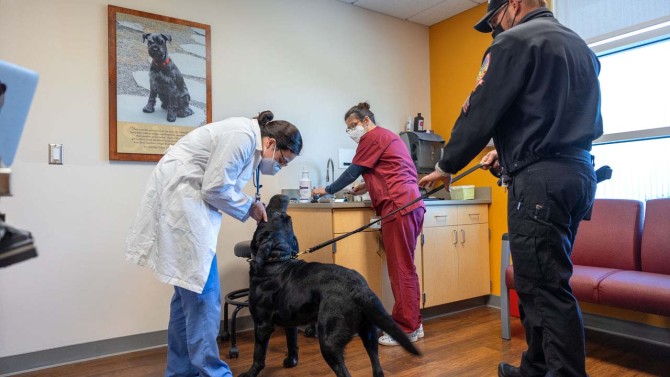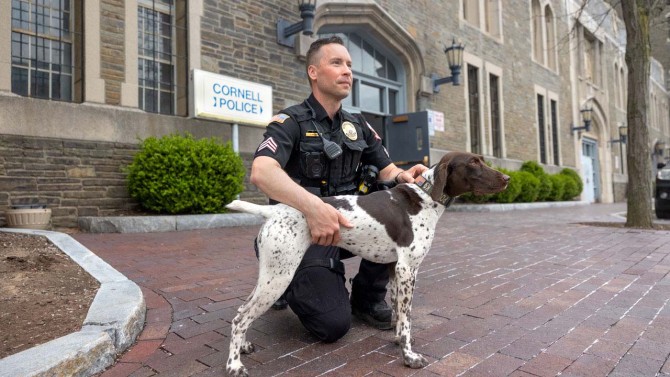CUPD’s K-9 units protect and connect
By Caitlin Hayes
In November 2021, when bomb threats stoked fear at Cornell and other colleges across the country, two members of the Cornell University Police Department were particularly prepared.
K-9 Luna and K-9 Axel, trained in explosive detection, were immediately mobilized, with support from other K-9 units in the region, to lead the sweep of campus. They searched three buildings each, floor by floor, to ensure it was safe for officers to proceed.
“There was an explosive threat, as well as an active shooter threat, and we’d never seen the two in combination before,” said K-9 Luna’s handler, Sgt. Justin Haines. “If there were an explosive odor or gun residue, or even someone who had become panicked and was hiding – [the dogs] would be able to pick up on that. It was rewarding to watch all our training come to fruition in a situation bigger than what we’d even trained for.”
Luckily, the threats were deemed not credible and the campus safe, thanks in part to the K-9 units. “Any time something doesn’t happen, that’s a good day for us,” said K-9 Axel’s handler, Sgt. Kyle Hollenbeck. “That means we’ve done our job.”
The K-9 program, started in 2001 by Deputy Chief Jeffery Montesano (now retired), is in its third generation of dogs, with Luna, a German shorthaired pointer who joined the force in 2021, and Axel, a Labrador who joined in 2019. The K-9 units sweep most large events on campus, including concerts, Commencement, Convocation, Alumni Weekend and visits from dignitaries – a requirement of the Secret Service. They’ll be on duty for Slope Day May 11.
The dogs and their handlers are also on call 24 hours a day to assist with bomb threats or detection needs in the region. Both dogs have three explosive detection certificates, two national and one state; they can also track both people and articles. And even when they’re not formally working, they’re helping to make their handlers approachable to students and the general public.
“It’s definitely something we look for in selecting our canines – can they do the job they’re getting paid to do but also make a super-excited little kid feel safe and comfortable petting an officer’s dog?” Haines said. “The interaction with the dog often leads to a dialogue with us, which allows the kids to see it’s not just somebody wearing a uniform, but an actual individual.”
“The dogs can help ease students’ stress during finals week, or for freshmen who are a little homesick, as well,” Hollenbeck said. “They see the dogs, it puts them in a better mood, and that’s a positive interaction with us.”
Initial training for explosive detection involves 240 hours of intense work, which used to be outsourced; Haines is now certified to train K-9 units, and K-9 Luna is the first CUPD K9 trained in-house. The canines maintain their skills with formal sessions one day a week – and constant informal training with their handlers, with whom they both live and work.
“They are a part of our family,” said Haines. “That’s where you get your bond.”
The process of choosing dogs for the unit is highly selective. They need to be both high-energy and approachable, as well as perfectly healthy. The dogs get their veterinary care from the College of Veterinary Medicine’s Small Animal Community Practice (SACP), and the students on rotation get hands-on experience caring for the dogs.
“Our rotation is very unique in that the students are really in the shoes of the veterinarian,” said Dr. Leni Kaplan ’91, primary care practitioner at the SACP. “They’re in the rooms, they’re doing the assessments and making the decisions. For the majority of the students, those who want to go into private practice, it’s the thing they do that most closely mimics the real world.”
Both K-9 Luna and K-9 Axel went through a thorough health screening at the SACP before they were admitted to the force, to check for underlying conditions that could prevent them from doing their work long-term. “Each dog is a big investment of time and resources,” Hollenbeck said. “So you want to make sure there’s nothing that will disqualify them initially.”
Kaplan said she and the students care for all the animals as if they were their own pets – but they take special considerations into account for working dogs. She may recommend being more proactive about tests, or prolonging rest after an injury, or she may try to avoid prescribing certain medications, ones that could impact the dog’s sense of smell, for instance. She also advises students to avoid separating the dogs from the handlers, if possible, because of their unique bond.
“Even learning how to manage and assess a high-energy dog like Luna – this is all wonderful experience for the students, who will certainly see working dogs in their practices,” Kaplan said. “It’s been a wonderful relationship, and the officers are the nicest people, so reciprocal in their respect. I’m so glad the vet school can support them in their work protecting our campus.”
The college also provides food for the dogs, which Hollenbeck said helps them stay within a tight budget. The K-9 program has been funded in recent years largely through grants from the New York State Division of Homeland Security and Emergency Services.
For all their specialized skills, the K-9s still bring the joys of non-working dogs, their handlers said.
“You could have a terrible day, but your K-9 partner is always happy to see you, wagging their tail with perked up ears and bright eyes,” Haines said.
Retired units K-9 Chase, who served eight years, and K-9 Rogue, who served six years, now live a more relaxed life with Haines and Hollenbeck, respectively, as family pets.
'Visions of Dante': Seeing the Italian poet with new eyes
Get Cornell news delivered right to your inbox.
Subscribe


